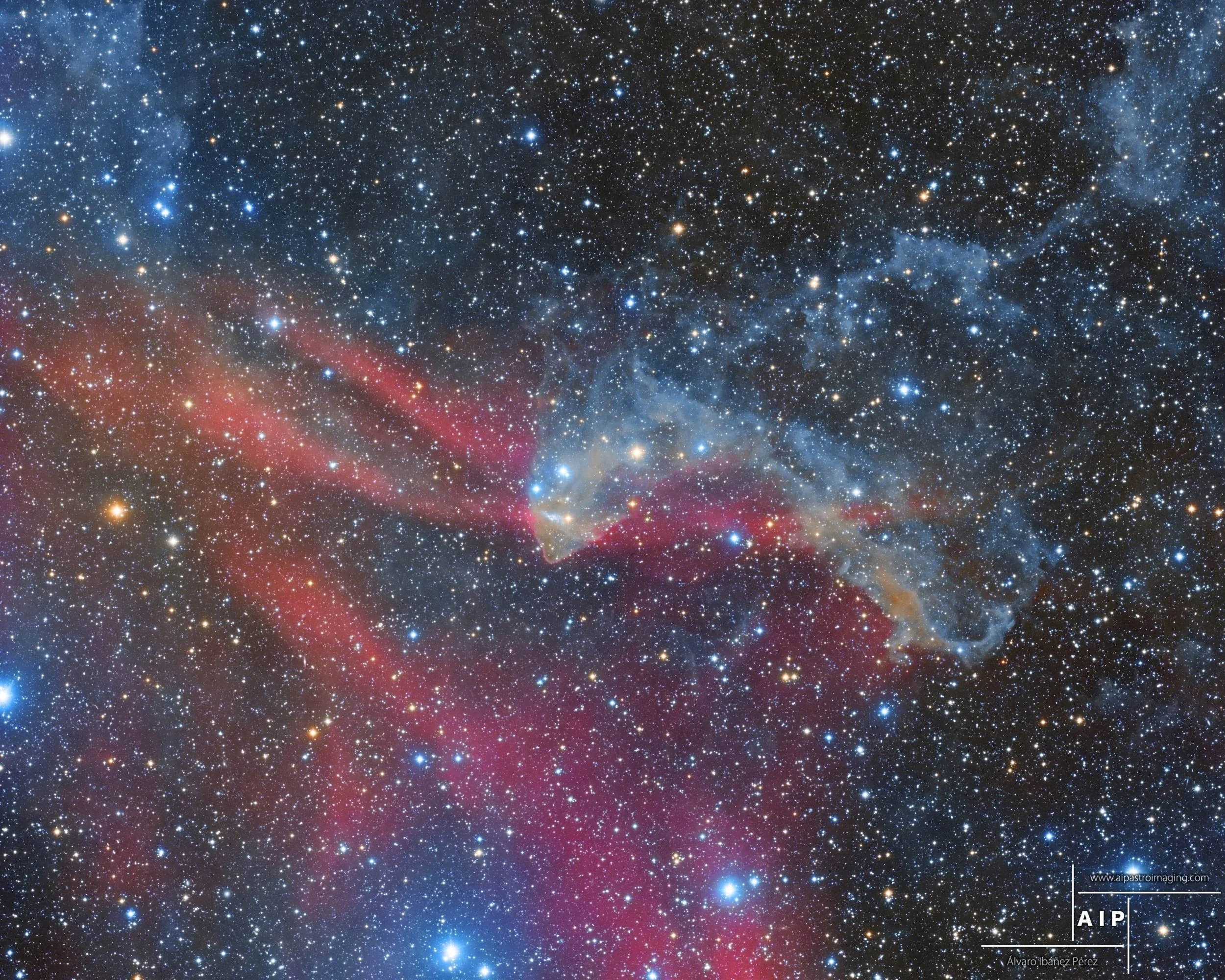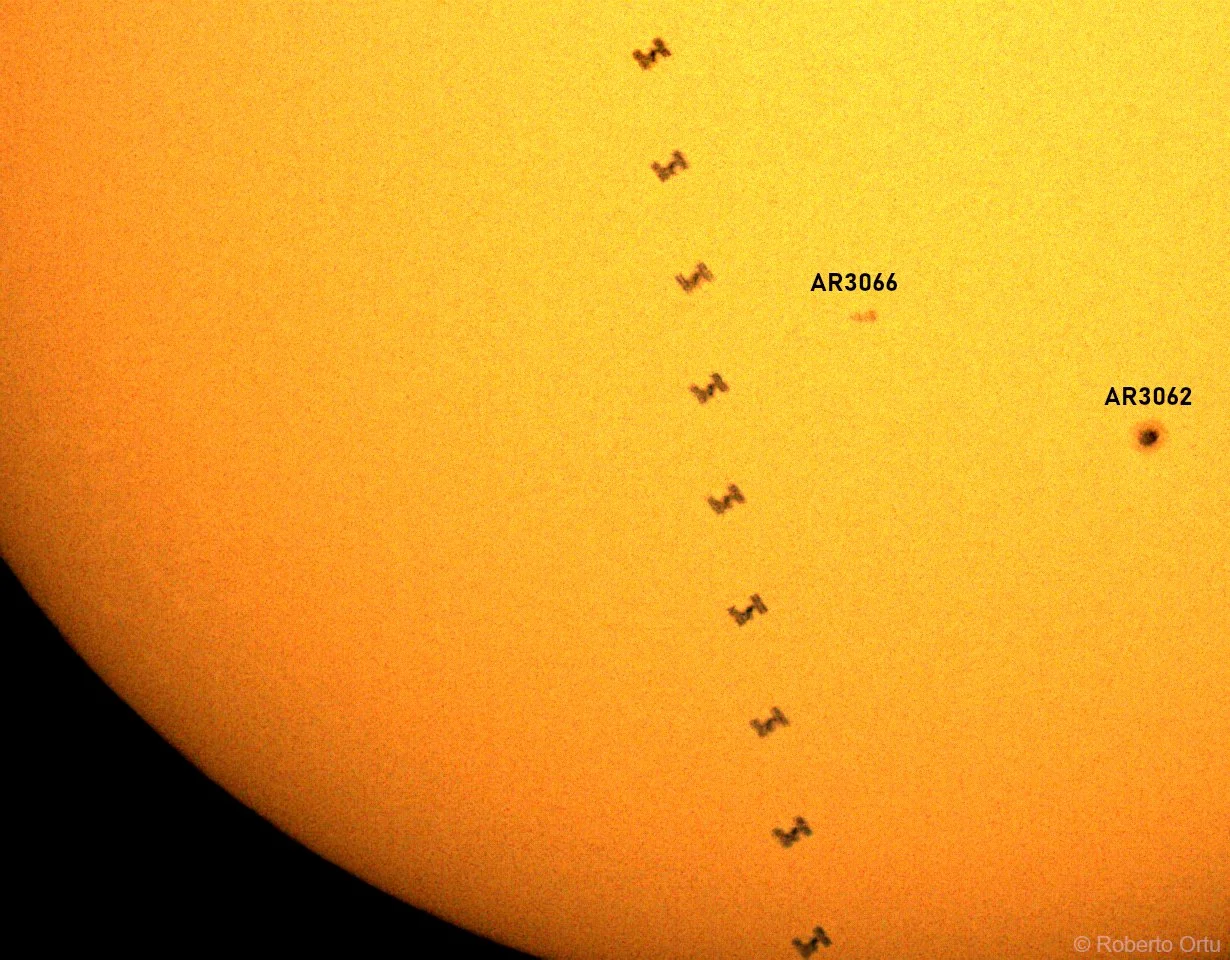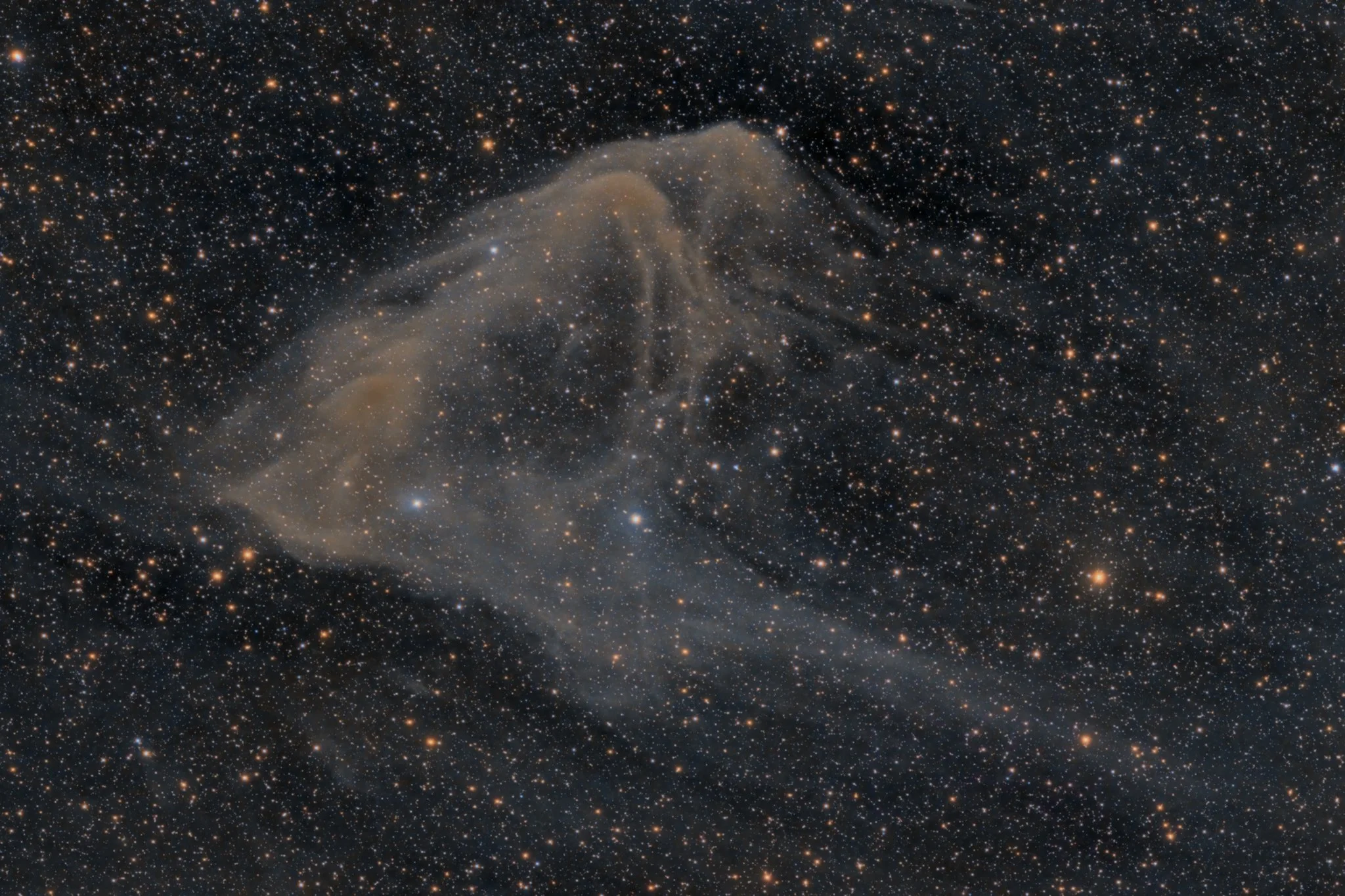
AAPOD2 Image Archives
2022
Monthly AAPOD2 Winners
Sh2-112
Image Description and Details : Sh2 -112 is a visible emission nebula in the constellation Cygnus..
It is located in the northern part of the constellation, about 1.5° west of the bright star Deneb; the most suitable time for observation in the night sky is between July and December and is greatly facilitated for observers placed in the northern hemisphere regions of the Earth.
It is a circular H II region with an apparent size of about 15', crossed by a dark band on the west side oriented north-south. The star responsible for its excitation is thought to be BD + 45 3216, a blue double star of spectral class O8V and apparent magnitude 9.18; estimates of the distance to this star give a value of 1740 parsecs (about 5670 light-years) which would place Sh2-112 in a particularly rich region of the Orion arm and physically very close to the large nebular system of Cygnus X.
Image taken in South Portugal in S2,Ha,O3,R,V,B
Total shot: 50H66
Set-up: Astrosib 400 on DDM 85 mount, Camera G3 16200
Processing PixInsight, Photohop
Copyright: Team ARO
Ngc 55
Image Description and Details : Object : NGC 55
Telescope : Planewave CDK17, Camera : SBIG STXL 11002, Tracking : Paramount
Location : Chile
Image processing software : Pixinsight, Photoshop
Total 43 hours 55 mins LRGB data
Copyright: Image captured : Martin Pugh
Image processing : Rocco Sung
Ngc7635
Image Description and Details : NGC 7635 Bubble Nebula
Distance from Earth: 11,090 light years
NGC 7635 (sometimes known as the Bubble Nebula or C 11) is a diffuse nebula visible in the constellation of Cassiopeia, towards the border with Cepheus.
It is a HII region, at the southern vertex of which there is an empty structure, caused by the pressure of the radiation of a central star of blue color (spectral class O), SAO 20575, of ninth magnitude, whose stellar wind reaches 2000 km / s; it is a blue Giant, which is also responsible for the ionization of the nebula, which emits its own light. Its distance from the Sun is estimated at 11,000 light-years.
Meade RCX 14 "
Ioptron Cem120
Moravian G2-8300
Astronomik filters
21x240s CCD
19x240s RGB
41x600s Ha
Copyright: Luca Dinoi
LBN 437 - Gecko Nebula
Image Description and Details : Telescope: Takahashi FSQ106EDX (f/5)
Mount: Takahashi EM-400 Temma2
Camera: Atik 16200 (KAF-16200)
Guider: Lunático EZG-60 + SXLodestar
Filters: Baader LRGB 50,8mm
Focus: RoboFocus Rev3.1
Flat panel: RB Focus eXcalibur
Distribuidor: RB Focus Balinor Pro
Acquisition: N.I.N.A.
Date: July 2022
Place: Guadalajara, Spain
Processing: PixInsight Core + Photoshop CC 2019
Exposure: L: 90x600s bin1, RGB: 30x300s bin2 each channel
Total: 22h 30min
Copyright: Alvaro Ibañez Perez
NGC 7377
NGC 7377 is located 100 million light years away in Aquarius. It is relatively small in the apparent field of view and has been very rarely imaged. It has been variously classified as lenticular and spiral. As seen in this image there is a spiral structure evident and faint out stretched arms. It is more probable that this is a spiral transitioning to a lenticular galaxy. The spiral structure has a heavy dust content and is quite dense towards the central portion of the galaxy. The overall shape of the galaxy indicates possible past interaction with another galaxy. Imaged in LRGB on our Planewave CDK 1000 at Observatorio El Sauce, Chile.
Image Processing: Mike Selby and Mark Hanson
The ISS transit in front of the Sun
Image Description and Details : This is my astroimage of the ISS transit in front of the Sun. In addition to the space station, some sunspots are also visible on the right.
Title: The ISS transit in front of the Sun
Technical data:
Celestron 114/910 Newton
Planetary camera QHY5L-II-C
Filter UV -IR cut
Filter Astrosolar
Software: Sharpcap, PIPP, GIMP
Location: Cabras, Sardinia, Italy
Date: 2022 July 26 15:41 UTC
Copyright: Roberto Ortu
The Cosmic Question Mark
Image Description and Details : This is a two panel mosaic revealing a collection of deep-sky objects straddling the border between Cassiopeia and Cepheus. It is sometimes called The Cosmic Question Mark. The large upper section is NGC 7822; and at its bottom is Sh-170 which provides the “dot” of the question mark. Turbulent rings of dust and gases frozen in time like some fossilized explosion, whose atomic emission is powered by energetic radiation from the central hot stars. Their powerful winds and radiation sculpt and erode the denser pillar shapes and clear out a characteristic cavity light-years across the center of the cosmic cloud. Stars continue to be formed in the pillars seen at the core …..
Telescope: Takahashi FSQ 106edx3
Camera: Zwo 2600mm pro
Filters: Antilla 3nm
Mount: Paramount MX
Sii = 45x4m
Ha = 22x4m
Oiii = 34x4m
Total integration = 6h44m per panel
Observatory – RoboScopes, Spain
Copyright: vikas chander
The Southern Crown
Image Description and Details : Corona Australis Nebula (NGC 6729) is a reflection nebula located 420 light years away from Earth in the constellation of Corona Australis. This nebula is the result of some bright stars that are inside a large and dusty cloud. It was the third variable nebula to be found and has been observed for over a century. It's considered a variable nebula because it changes its apparent brightness due to changes in the stars that illuminate it.
I took this picture on two different nights, resulting in a total of 5h15min of exposure.
Equipment: Canon 60D Astromodified, Askar ACL 200mm, Ioptron Skyguider Pro.
Exif:
315 x 1min
ISO 1000
200mm f/4
Location: Nova Petrópolis, Rio Grande do Sul, Brazil
Copyright: Guilherme Drumm Warpechowski
SH2-63
Image Description and Details : SH2-63 is an emission nebula in the constellation Sagittarius located approximately 1000 light years from earth. Also known as LBN 86 it is classified as an HII region. In this image, you can see some of the galactic cirrus or Integrated Flux Nebula (IFN) surrounding this region.
I stumbled across this object while panning around in Stellarium looking for a new target. I don't see many images of it and thought it would be fun to try.
Integration time: ~15 hrs LRGB (6:3:3:3)
Telescope: Skywatcher Esprit 100 ED APO
Imaging Camera: ZWO ASI 2600MM Pro
Guiding: Skywatcher EVOGuide Scope with ZWO ASI120MM camera
Filter: Optolong LRGB
Mount: Skywatcher EQ6R-Pro
Calibration: Flats and flat darks
Hardware Control: ASIAIR Pro, Pegasus Power Box and ZWO EAF
Processing: The selected images were pre-processed and processed using Pixinsight.
Copyright: Jason Dain
Venus
A collection of Venus images taken from my observatory in the period April-July 2022.
The images combine Infrared, 820-920nm, and Ultraviolet, 320-380nm, data.
A Cloud discontinuity is also visible in one of the images.
The setup used:C14 Edge HD, Fornax52 mount, ASI 290mono, FFC Badder Barlow, Baader UV320-380nm, Baader SLOAN z-s'820-920nm.
Agerola-Amalfitan Coast-Italy
Copyright: Luigi Morrone
Wizard Nebula (Sh2-142)
Image Description and Details : A seasonal classic, the Wizard nebula, in a bicolor HOO version with RGB stars.
The Wizard Nebula, cataloged as Sh2-142 (Sharpless2 142) is a diffuse HII region in the constellation Cepheus associated with the star cluster NGC 7380.
Konus 200/1000 @960mm, f4.8
Qhy168c @-5 °C
Sky-Watcher Eq6r Pro
Optolong L_eXtreme 128x300"
SvBony UV/IR-cut 60x60"
Kstars/ekos, APP, PixInsight, PS
Copyright: Massimo Di Fusco
NGC 6960 - Veil Nebula
Image Description and Details :
This image was taken in South of France with an Esprit 120ED and an Asi 294MM Pro. I used Ha and OIII 4.5nm narrowband filters with 11.5 hours of exposure on the Veil Nebula in Cygnus constellation.
Copyright: Benjamin LEFEVRE
Sh2-115
Image Description and Details : Sh2-115 is a faint emission nebula in Cygnus, just about 1.5 degrees northwest of Deneb, the brightest star of the constellation. Inside Sh2-115 can be found the small open cluster Berkeley 90 . For long time Sh2-116 has been considerd a planetary nebula (even has its proper designation Abell 71, PK 085+04.1,or PN G084.9+04.4). But the recent studies describe it as a small patch of emission nebula Astrosib RC 20"+camera FLI Kepler 4040 cmos HOOrgb=19h06 no guiding The SkyX + Pixinsight + Photoshop From E-eye (Fregenal de la sierra, Spain)
Copyright: Georges Chassaigne
C 5068 : The Forsaken Nebula
Image Description and Details :
IC 5068 : The Forsaken Nebula (2 panels mosaic) This is IC 5068, a low emission nebula (composed of clouds of hydrogen gas), neglected because it is located near the very photogenic North America and Pelican nebulae. The nebula is best known for the streaks of dark clouds that separate the hydrogen-colored regions, which also separate the nebula from its better-known neighbors. (All are located 1,600 light-years away in the constellation Cygnus.) Shooting data: : ASA Newton 254/950 F3.6 : Paramount MyT : ZWO ASI2400MC at -10°C + Artesky rotator : IDAS LPS-P3 and IDAS NBZ Nebula Booster : Skywatcher Evostar72ED + ASI290MM mini : TheSkyX pro, NINA, PHD2, AstroPixel Processor, PixInsight, Photoshop : Panel N°1 = 10h15 (41x900”) in HaO3 and 4h00 (24x600") in RGB for stars : Panel N°2 = 10h30 (42x900") in HaO3 and 3h40 (22x600") in RGB for stars : TOTAL = 28h25 : Lorraine, France : Over 8 nights: June 17, 2022; June 18, 2022; June 27, 2022; June 29, 2022; July 1, 2022; July 2, 2022; July 4, 2022; July 14, 2022
Copyright: Thomas LELU
The Pillars of Creation
Image Description and Details :
I aimed to recreate the Iconic Hubble Space Telescope image Pillars of Creation. It was my first project I did at such a long focal length (Celestron C11 EdgeHD - 2800mm) and the struggle was real... :) I took my telescope to a semi-dark site for a weekend for the first tests. I knew it would take me about three nights to take this image, calculating a night's worth of shots per color (using filters for Hydrogen, Sulfur and Oxygen). I threw away the images from the entire first night (5 minute shots) as the guiding was not able to keep the stars small enough. I spent three more nights taking 1-minute subs for the final image, many of which also had to be discarded unfortunately. I ended up using a total of 175 minutes of Hydrogen, 192 minutes of Sulfur and 104 minutes of Oxygen. Celestron C11 EdgeHD Rainbow Astro RST-135, RST-300 ZWO ASI 1600MM 06-07.2022
Copyright: The Space Koala / Luca Bartek
Needle galaxy
Image Description
Location: Dark Sky New Mexico
Telescope: Planewave CDK-17
Camera: FLI PL16803
Mount: Paramount ME
Luminance: 27x20 minutes (binned 1x1)
Red: 16x15 minutes (binned 1x1)
Green: 16x15 minutes (binned 1x1)
Blue: 16x15 minutes (binned 1x1)
Copyright 2022 Bernard Miller
NGC 6888 and WR 134 widefield [HOO]
Image Description and Details : In the summer months we can capture the wonderful nebulae region in the constellation Cygnus. In this frame the beautiful Crescent nebula and the material from the hot star WR 134 with their surroundings can be seen in full glory. The image is a combination of Ha data and Oiii data. The data was captured from the backyard in the Netherlands. Equipment: - Sky-Watcher HEQ5 PRO - William Optics Redcat 51 - ZWO ASI294MM PRO bin1x1 - ZWO ASI120MM Mini - ZWO EFW 8 x 31/1.25" - Astronomik 6nm Narrowband filters SHO Acquisition: 13.3 Hours - HA: 80 x 300s - OIII: 80 x 300s
Copyright: Sven van Veen
Ic2944
Image Description and Details : Camara principal : ZWO ASI 294MM Pro Camara guia : ZWO ASI174MM mini Telescopio guia : Starguider 60/240 Filtros : Optolong 1.25" - Ha - OIII - SII Telescopio : Sky-Watcher 250 PDS Newton Montura : Ioptron Cem 70 Programas : Sharcap, PHD2, Pixinsight, photoshop, Sequence generator pro Lugar : Santiago de Chile Escala de cielo : Bortle 9 Detalle de adquisicion: Ha : 100x180" (5hr)(gain;120) - 20C bin 2x2 OIII : 60x180" (3r)(gain;120) - 20C bin 2x2 S2 : 60x180" (3Hr)(gain;120) - 20C bin 2x2
Copyright: Juan Pablo Moraga Coloma
NGC 6559
image Details:
PlaneWave CDK-20 20" f/7.7 Astrograph
PlaneWave L-500 Mount
QHY600M CMOS Camera
Total exposure: HaLRGB 11.9 hours
Sierra Remote Observatories
June 2022
Data acquisition by Eric Coles
Image processing by Bob Fera
This image presented some interesting processing challenges, but I'm pretty happy with how it came out. Big shout-out to Russ Croman and his Photoshop plugins, which were invaluable to getting this one done!
Copyright: Bob Fera
Rho Ophiuchi molecular clouds complex mosaic
Image Description and Details : The main goal of this project was to capture the exceptional, extremely colorful, gigantic region enclosing the emission, reflection and dark nebulae around stars named Rho Ophiuchi, Antares and Alniyat, as well as neighboring objects (M4 globular cluster and others). This region is commonly referred as Rho Ophiuchi Molecular Clouds Complex in the astronomical literature. The nebulae have very intensive colors depending on the ionized and molecular gas composition (yellow-orange and reddish colors) or due to the visible light reflexion (blue colored nebulae). Dark nebulae does not transmit much light due to the presence of interstellar dust. This region covers a gigantic region on the night sky compared to many other deep space objects and is located on the border of the Scorpius and Ophiuchus constellations. A total length of 8 Full Moons could be placed side-by-side on the wider, horizontal side of this mosaic. The high dynamic range of colors and contrast in each panel, as well as the size of each file (few gigabytes due to the high resolution) resulted in complex and unusually long computer processing procedures. This 4-panel mosaic is produced by combining the integrated data collected using two different telescopes (Askar FRA400 and William Optics FLT-91) in the last two years. The same astronomic camera (ZWO ASI294 MM Pro with thermoelectric cooling) and same dichroic broad-range filters (Chroma RGB set) were used. Total integration time is on average 4.5 hours per panel. Imaging sessions required a total of 7 car trips to two different locations (Rudine near Skopje and Radibush near Kriva Palanka) spanning driving around 800 km. Difference in the telescopes focal length (280 and 432 mm) and changes in the atmospheric conditions between different nights impose real processing challenge. Technical details Telescope: William Optics Fluorostar 91 and Fla t6AIII focal reducer/flattener (fl=432 mm). Imaging camera: ZWO ASI294MM Pro. Guiding camera: ZWO ASI174MM Mini via ZWO OAG;. Guiding and acquisition control: AsiAir Plus. Mount: iOptron CEM40EC. Filters: Chroma (RGB). Frames: Red: 124x180" (6h 12') (gain: 120.00) -15°C bin 1x1; Green: 128x180" (6h 24') (gain: 120.00) -15°C bin 1x1; Blue: 121x180" (6h 3') (gain: 120.00) -15°C bin 1x1. Total integration of the mosaic: 18h 39m. Integration per panel: 4h 40m. Dates: June 4, 2021 · June 8, 2021 · July 6, 2021 · May 24, 2022 · June 2, 2022 · June 27, 2022 · July 4, 2022.
Copyright: Sasho Panov


















![NGC 6888 and WR 134 widefield [HOO]](https://images.squarespace-cdn.com/content/v1/5debd4b16fcd7b02905712ff/1658630975836-EOV12WMSPLD4Y88Z7VQB/Crescent%26WR-134_lowres.jpeg)


